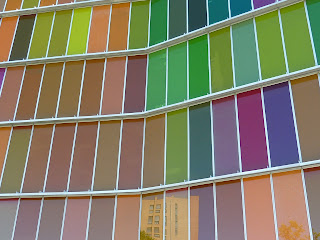La Rioja Province, wine country
Lovely train ride from León to Logroño (figured out how to add special characters, not easy but it works).
I was a bit nervous about switching trains in Miranda de Ebro (as I knew it would be a short stop and I have a big bag). In my effort to be quick and efficient at getting off the train, I pulled a spot in my thoracic spine. Trauma from a car accident years ago left me vulnerable to injury in this area. I was so happy to know I had a full week in an apartment which gave me the luxury of time to get things back in order. Many thanks to my teacher, Jenny Otto of Body Balance Yoga, for teaching me so many tricks. Add to that full Rx strength Ibuprofen 600 mg from the local pharmacy for less than 6 cents a pill and I'll be ready for next big train trip on Monday.
Walking, walking, and more walking. While I was very active before I left, most of my time was spent on my bike, SUP, a yoga mat, or pilates reformer. Since I arrived in Europe, I walk for several hours each day.
Highlight of my trip in this area was my full day with Rioja Tasting Travel and our fabulous guide José. We set off at 9:30 and spent the 1st hour driving up into the hills and mountains.
Check it out on Google maps La Rioja , the La Rioja region is a small province but is home to 601 wineries or bodegas, as they called here, translates to cellar.
I learned lots about the region and about the wine during the tour. Just 5 of us, 2 couples and me. Rioja region wines all have a colored label identifying their classification. Green for young, red for Crianza, dark red for Reserva, and blue for Gran Reserva. I've always enjoyed riojas and had seen the colored labels before but never knew what it meant. Our guide told us that it is a big misconception that Gran Reserva wines are the best. The young wines tend to showcase the latest innovations by the winery. The colored label may be on the back of the bottle or the neck. Rioja labels More good info about the wine region Rioja info
We tasted about 16 wines. Most were young and delicious. We also had the good fortune of tasting a couple whites and claretes, much less common but gaining popularity so the wineries will be making and distributing more of them.
 |
| a chozo, a traditional beehive-shaped stone hut used during harvesting |
 |
| one of the many medieval towns with a castle |
 |
| River Ebro winding its way through the valley |
 |
| foreground are the chimneys in the cellar to allow the CO2 to escape |
 |
| vines, vines, and more vines |
We visited 5 cellars and had a fabulous lunch of wood fire grilled lamb chops and sausage at the lovely Bodega Lecea. Some of the cellars here date back to the 16th century. Bodega Lecea
 |
| inside the Bodega Lecea and looking up at one of the chimneys |
 |
| one of the very old cellars, lovely smell down here |
 |
| a goat skin used to carry wine |
 |
| clarete at Lecea, one of my favs |
On to the largest and oldest bodega in the region:
 |
| dramatic roof of the hotel on site |
 |
| one of the many barrel rooms |
 |
| enjoying the barrel room, in this case barrels of young wine (green) |
 |
| The owners private collection of 140,000 bottles |
So pleased I took the opportunity to come to this part of Spain. What a lovely time of pintxos (tapas in this region), wine, walking, and learning about Rioja.
Big train ride tomorrow, will be on the high speed TGV.




















































